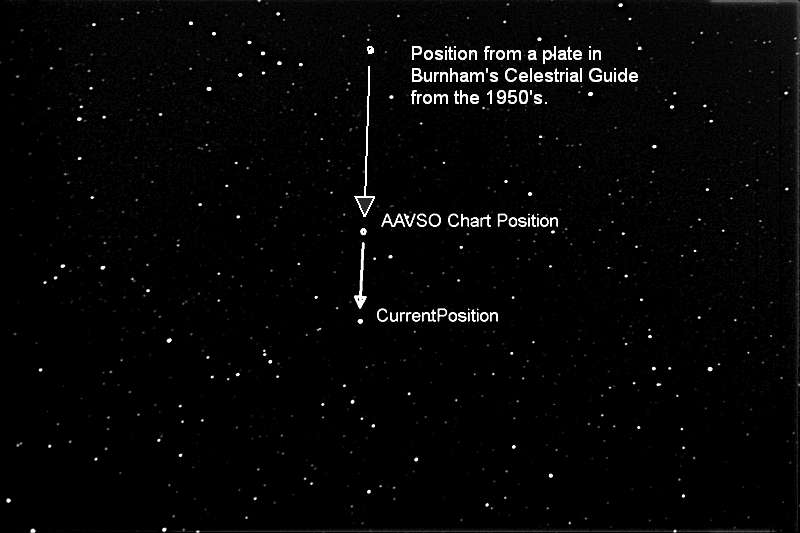
In today’s quest for dark matter, black holes and active galactic nuclei, small dwarf stars tend to get overlooked. The fact that small amateur telescopes can image a star seem to indicate there is little of interest remaining to the professional for study. Being able to study a star with a small aperture also does not lend itself to procuring today’s cutting edge equipment for sexy science. Since stars were extensively studied near the turn of the 20th century many scientists feel it is time to move on to the next great mystery, whatever that might be. In my warped thinking this seems to be a good place to start to look for something interesting. Especially with the sophisticated equipment available today.
The great observer E.E. Barnard discovered the high proper motion of V2500 Oph in 1916 after examining photographic plates from 1894 and 1916. At the time Barnard was a professor at the University of Chicago’s Yerkes Observatory in Williams Bay Wisconsin. Not only was he a very skilled astro-photographer but was also a very seasoned visual astronomer. In the late 1800’s and early 1900’s a good astronomer had to be good at the old visual/sketching observing as well as pushing the envelope with photographic observing.
Barnard’s Star is a M5 star. This means it is a cool red dwarf star and is easy to observe with a small telescope since it is only 6 light years away. A high proper motion star is one that seems to be moving very rapidly across the night sky. Since it is close and has a rapid velocity it moves 10.29″ across the sky every year. You can see how it has moved in the above image taken with Temple 28. Barnard’s Star is moving at the rate of 103 miles per second. This means that in 351 years this star will move 1 degree in the sky. Compared to other stars this is a Porsche among snails. There are other objects that are faster but none of them as close, so it’s velocity is readily noticed here on earth!
This high proper motion as well as it’s relative ease of imaging caused a great deal of controversy. Dr. Peter Van De Kamp an astronomer at Swarthmore College’s Sproul Observatory. Dr. Van De Kamp used the 24″ refractor to observe Barnard’s Star from 1937 until the early 1970’s. He found a “wobble” in the proper motion of the star that led him to conclude that the star had a large planet orbiting. Until his death in 1992 he tenaciously held onto the idea that he was the first exo-planet discoverer.
In 1973 astronomers George Gatewood of the Allegheny Observatory and Heinrich Eichhorn of the University of Florida, using data obtained with improved equipment on the 30-inch Thaw Refracting telescope, did not detect any planets but instead detected a change in the color-dependent image scale of the images obtained from the 24-inch refractor telescope at the Sproul Observatory used by Van de Kamp in his study. Astronomer John L. Hershey found that this anomaly apparently occurred each time the objective lens was removed, cleaned, and replaced. Hundreds more stars showed “wobbles” like Barnard’s Star’s when photographs before and after cleaning were compared – a virtual impossibility.
Since then there have been numerous attempts using modern techniques to discover exo-planets around Barnard’s Star without avail. Since this star is only 6 light years away finding a planet would be a boon for study. It is much easier to study a planetary system 6 light years away compared to one 60 light year’s away. The Red Dots (https://reddots.space/photometry-log-4-end-of-campaign/) has imaged Barnard’s star repeatedly looking for any kind of signal change that would signify a planetary transit. Other than the obvious that the M class star is very slightly variable (4%), no eureka moment can be found!
In one long time series ( 60 second exposure) of Barnard’s star from Temple 28, the star exhibited a really strange light curve. Turns out it was over exposed. It was way over exposed, which is a common error of those of us that tend to image much fainter stars than Barnard’s. Doing another long time series (15 second exposure) yielded similar variability to what the Red Dots Campaign found. My cadence for the images is pretty slow since it takes around 70 seconds to upload an image to the computer. Therefore it is hard to see the shape of the actual light curve. With my equipment all that I can really tell is that it is a micro variable that varies around 4%.
Next observing season I hope to image with the AR102 (Temple 10) and do a 20 second cadence instead of an 85 second cadence. This might reveal the actual shaped light curve so the nature of the variability can be determined.
Barnard’s Star is a star that still holds interest for Citizen Scientist and Professional alike!